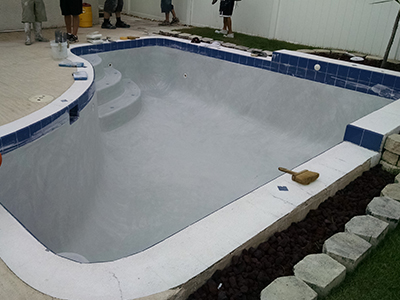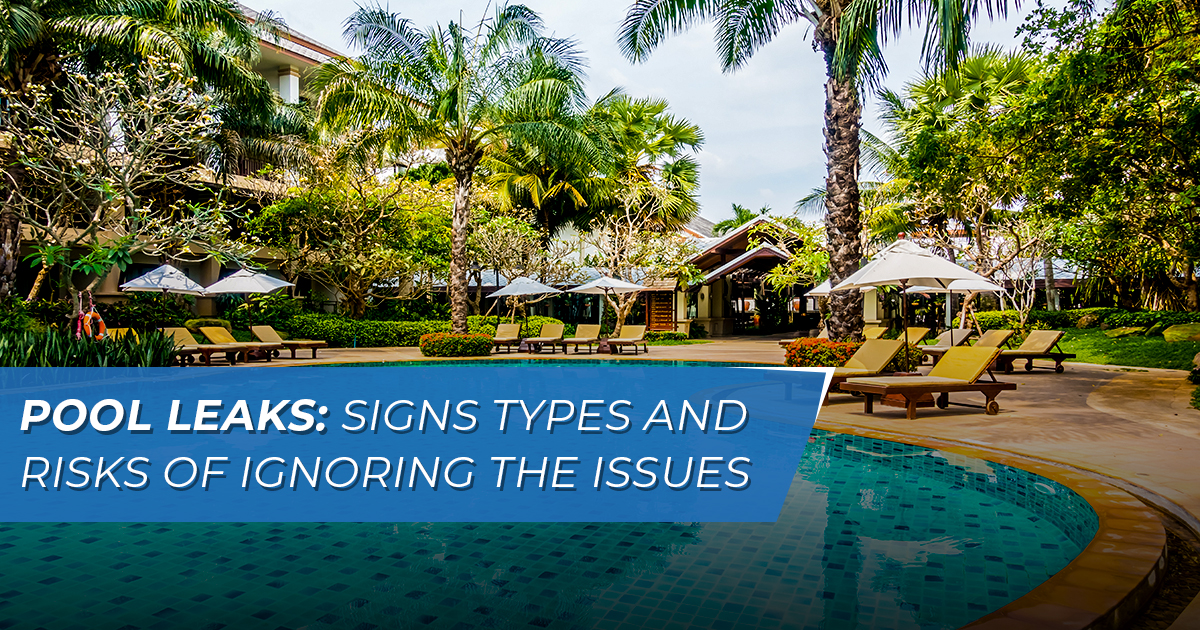Pool Leaks: Signs Types and Risks of Ignoring the Issues
A pool boosts your home’s value and offers a great place to cool off in the summer. However, there’s always a chance of a pool leak developing. Knowing the early warning signs of pool leaks is crucial to spotting water issues before they can erode soil and cause issues to the pool’s stability. Leaks can spread underground without detection for years, even potentially threatening your home foundation due to moisture issues. While you should always be on the lookout for signs of a swimming pool leak, you may need professional leak detection to actually determine where the water is escaping from for proper repairs.
Common Types of Pool Leaks
 There are three main types of pool leaks to watch out for when owning a pool. The first is the leak in the plumbing connected to the pool. In auto-filling pools, this is often the top cause of a leak that increases the monthly water bills for the home without lowering the level of the pool. Since water escapes before it reaches the pool, this type of leak may not make a noticeable change to the water level. Similar leaks in plumbing connecting the filters and skimmer equipment may lower the pool’s water level since they prevent proper recirculation.
There are three main types of pool leaks to watch out for when owning a pool. The first is the leak in the plumbing connected to the pool. In auto-filling pools, this is often the top cause of a leak that increases the monthly water bills for the home without lowering the level of the pool. Since water escapes before it reaches the pool, this type of leak may not make a noticeable change to the water level. Similar leaks in plumbing connecting the filters and skimmer equipment may lower the pool’s water level since they prevent proper recirculation.
The second common type of leaking from a pool is the structure or shell leak. This involves a crack, tear, or another form of damage that compromises the general shell designed to hold water in. These can be some of the hardest leaks to detect because the cracks and tears are often invisible. That’s where the power of leak detection comes in handy. By pinpointing where the moisture has reached the soil and penetrated through the shell, it’s easy to establish that you’ve caught every leak and completed enough repairs to restore the seal. Pools often need draining or complete repairs for this kind of leak.
The third type of pool leak is catastrophic water loss due to a malfunctioning valve. Most pools feature hydrostatic valves to balance the pressure between the inside and outside of the pool’s structure. If this valve becomes stuck open due to debris, it can allow your pool to drain itself despite your efforts to keep it filled. The multiport valve on a pool’s filter tank that allows for backwashing also has a chance of leaking this way. A quick inspection will determine if either of these two valves can be the cause of the water loss.
Related Article: Pool Leak Bucket Test: How and When to Do It
What Are the Signs of a Potential Leak?
First, consider how much water your pool is losing per day. You can use the bucket test to quickly find out by setting up a bucket of water next to the pool in the same conditions. If the bucket loses significantly less water per day to evaporation than the pool, you’re likely dealing with a leak. Losses of more than 1/4 inch per day also should be considered a warning sign since even hot dry weather can only evaporate so much water per day. Pools losing water can become difficult to keep in proper pH balance, although that may have other causes. Keeping your pool sparkling blue means patching leaks when they’re discovered so you don’t lose valuable water and chemicals. Increasing water bills for auto-filling pools and higher costs from professional maintenance services may indicate a leak as well.
Other signs of potential leaks will occur around the exterior edges of the pool. Watch out for greener than usual grass growth, brown patches where grass has died off from chlorine or excess water, and soft, muddy patches that never seem to dry. Not only do these signs indicate extra water is escaping from the pool, but you can start narrowing down where the leak is potentially located. It’s not enough to just know the pool is losing water. You’ll also need to determine where the leaks are located and how many you’re dealing with before heading into the right repair for the situation.
Related Article: Pool Leaks: Signs Types and Risks of Ignoring the Issues
The Steps in Detecting a Pool Leak
 Detecting a pool leak usually begins with the homeowner noticing signs like wet soil or dropping water levels. You may want to try some simple tests like dropping in pool testing dye to see if it’s pulled to any particular part of the walls. Food dye can be used in most pools without concerns about discoloring the walls of the pool. However, leak detection is a more complex process than just these simple tests. Using a soil probe to determine exactly where moisture levels are higher than usual is the best way to truly narrow down the locations. If you miss a few leaks, you’ll find your pool continues leaking despite repair efforts. Our detection services rely on the latest types of technology for soil probing to determine where leaks are occurring, along with skilled inspections to verify if there are any plumbing issues. We can help with any kind of in-ground pool to make sure water stays where it’s needed.
Detecting a pool leak usually begins with the homeowner noticing signs like wet soil or dropping water levels. You may want to try some simple tests like dropping in pool testing dye to see if it’s pulled to any particular part of the walls. Food dye can be used in most pools without concerns about discoloring the walls of the pool. However, leak detection is a more complex process than just these simple tests. Using a soil probe to determine exactly where moisture levels are higher than usual is the best way to truly narrow down the locations. If you miss a few leaks, you’ll find your pool continues leaking despite repair efforts. Our detection services rely on the latest types of technology for soil probing to determine where leaks are occurring, along with skilled inspections to verify if there are any plumbing issues. We can help with any kind of in-ground pool to make sure water stays where it’s needed.
Related Article: Pool Leak Detection Kits: Do They Work?
Risks of Ignoring a Leak
Letting a pool lose water does more than just make it hard to enjoy swimming in the summer. You’ll strain the equipment that circulates and filters the water, risk damage to the shell due to unequal pressure on the material, and find it difficult to keep the pH balanced. Leaks can cause damage to the surrounding yard by killing off grass or by causing the soil to erode, leaving an open space. A long-term leak could risk damaging the pool’s structure or your home’s foundation. Prompt leak repair is the best way to prevent these problems.
Related Article: How to Find and Fix a Pool Leak
Expert Pool Leak Detection Services By GPS Pools
Choose GPS Pools for your maintenance needs, including pool leak detection services. When you contact us at our New Tampa, Lutz, or Land O’ Lakes locations, give us any details about signs of water loss or tests you may have attempted on your own. We’ll quickly get down to the root of the issue and make recommendations for repairs, which may range from the replacement of damaged equipment and plumbing to a complete overhaul of the pool’s structure.

